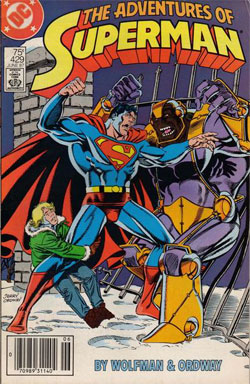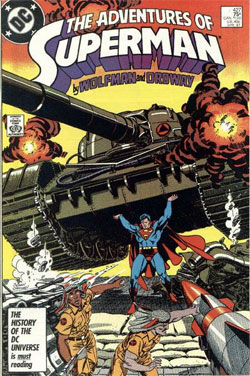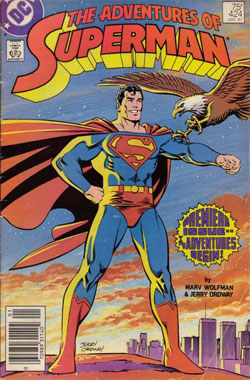Superman Comic Books
Superman: Special Reports
Wolfman & Ordway's "Adventures of Superman" - Part 1 (of 2)
Author: Sean Hogan (shogan@buckho.com)Last updated: December 31, 2001
 Storytelling In The Super-Titles
Storytelling In The Super-TitlesRather than discuss stories about one character, this time I'm going to review the first year of Adventures of Superman (cover dates January to December, 1987). The series picked up the numbering of the original Superman comic which ended with #423 (part 1 of Alan Moore's classic imaginary story "Whatever Happened To The Man Of Tomorrow?" followed in Action Comics #483, also collected in trade paperback).
Reviewing these stories provides an opportunity to examine a number of topical discussions, such as the serial nature of the Super-titles storytelling. as well as some of the themes that develop both in later stories and in real life as Superman takes on terrorism.
DC's editorial approach at the time was to recruit "top talent" to write and draw the Superman comics. John Byrne was given the task of re-booting Superman with The Man of Steel miniseries and with the regular titles, Superman and Action Comics. Marv Wolfman, just off Crisis on Infinite Earths and the New Teen Titans, and Jerry Ordway (All Star Squadron and Infinity Inc), were given Adventures of Superman.
The quality of the Super-titles has risen and fallen and risen again. DC's policy for the writers and artists used for the Super-titles has been inconsistent over the years, including the decision not to use established "top talent" Mark Waid and Grant Morrison when they wanted the job. DC also decided not to have Jerry Ordway return to the Super-titles after his Power of Shazam! series ended its run. At the time, DC gave opportunities to writers and artists that they presumably felt had development potential. For a long period, there was a trend to promote from within by giving artists a crack at writing (Stuart Immonen, Jon Bogdanove, and Dan Jurgens). More recently, the editors have been choosing writers and artists from outside the Super-titles, and even outside DC (Jeph Loeb, Joe Kelly).
Does this make a difference to the quality of the comics? Certainly the issues reviewed here by Wolfman and Ordway are of higher than average quality. However, even Wolfman writes one stinker in this batch.
Another factor affecting the quality of the comics is the serial nature of the Super-titles, where the story is often handed, baton-like, from one comic team to the next on a weekly basis. A chain is only as strong as it's weakest link - making the editor's job even more important to ensure that the quality and consistency remain high in each episode.
In 1987, the three (at the time) regular series were not serial, interlocking stories. They told different tales and had different focuses. Superman concentrated on the superhero, Adventures of Superman emphasized Clark Kent, and Action Comics featured team-ups. While there was some cross-continuity (e.g., if a character broke an arm in Superman, he had a cast on it in Adventures of Superman), each comic told a separate story.
Although the task of Adventures of Superman was to focus on Clark Kent, Wolfman doesn't ignore the action and each issue has Superman battling someone or something. Between the action scenes, Wolfman weaves his plots and sub-plots dealing with Clark and the supporting cast.
The majority of the issues are all credited to Wolfman and Ordway, with Wolfman scripting and Ordway drawing.
The interior art is consistently good and often excellent. Ordway is able to portray both action and quiet scenes with equal power. In issue #429, Ordway creates some stunning scenes of Superman destroying planes and picking up a submarine to ram it into a battleship. In issue #430 he has some very effective scenes with Ma and Pa Kent having a conversation with Clark at home. Ordway is able to convey as much of the story with his art as the writer does with his words.
Ordway is known for his painted covers on Power of Shazam! (and the excellent and highly recommended painted graphic novel of the same name), but his pencil and ink covers on Adventures of Superman do not suffer in comparison. The covers are grand and majestic. The first issue has a classic pose of an eagle alighting on Superman's outstretched arm. The majority of the covers reflect Superman's power and iconic presence bursting through walls, lifting tanks, snatching bullets out of the air, and slugging it out with villains.
The Overplot
 The arc that runs through the first year of Adventures of Superman deals with a mysterious group called the Circle. We don't learn of the group until issue #427, but it is behind terrorist attacks that start in #424. While individual issues make interesting use of the Circle, ultimately Wolfman fails to develop or use the plot to full potential. Part of the problem is that he makes the Circle too mysterious.
The arc that runs through the first year of Adventures of Superman deals with a mysterious group called the Circle. We don't learn of the group until issue #427, but it is behind terrorist attacks that start in #424. While individual issues make interesting use of the Circle, ultimately Wolfman fails to develop or use the plot to full potential. Part of the problem is that he makes the Circle too mysterious.
The origin and purposes of the Circle are never fully explained. It seems that the members of the Circle pre-existed mankind, and the group has plans to rule and control humanity. However, they are also seeking a missing member, one that they need to "complete the Circle" and to leave this world for another. They wonder if Superman is one of them and if he can be convinced or coerced into joining them.
In issue #427, we meet two members of the Circle. The male, Prana, is dressed in Arabic clothing but resembles a humanoid cat. Prana's wife, Zahara, warns that moving into Superman's emotions could kill him. Prana's mind merges with Superman and attempts to convince him to join the Circle. Superman resists the mental attack, refusing to accept the illusions sent to him. The feedback kills Prana, although Superman is unaware of his death or the source of the illusions.
Two later issues (#429 and #430) have the Circle sending some of its members to try and kill Superman in revenge for Prana's death. The plot concludes in Wolfman's final issue, #435 when, once again, the Circle contacts Superman through telepathic illusions, urging him to meet with them. The mysterious members gather together on the 13th floor of 666 Tenth Ave -- the Jurgen's Building.
Zahara tells again of the death of her husband, Prana, but says that the attempts for revenge were wrong, for Superman did not know he caused the death of Prana. However, she announces that tonight is the time prophesied for them to leave Earth and she vows that if Superman will not help them, he must die for imprisoning them on this planet.
As Superman enters the building, he is again assailed by visions and illusions in the forms of those he knows. The attempts to force him to join with the Circle fail and, in the end, all Zahara can do is explain why they need him and ask for his help. In typical fashion, Superman agrees to help, saying that they should have asked in the first place rather than attack him. He says, "To be rid of you is enough." He joins hands with Prana and suddenly she and the Circle are gone while Superman floats above the destroyed remains of the building.
While the plot had potential, in the end it is disappointing. We still don't know anything about the origin or history of the Circle or any of its members. The motivations and actions are contradictory (to rule mankind and/or to leave Earth; to co-opt Superman and/or to kill him). Worse, after a great build-up, the ending is anti-climatic. Following violent confrontations, there is only a brief meeting between Superman and Zahara, with little in the way of explanation, leading to a sudden, also unexplained, disappearance. Dorothy showed more dramatic flair when she clicked her ruby shoes three times and chanted, "There's no place like home".
Not to be too pessimistic, aside from my problems with the resolution, the stories themselves were well written, interesting and suspenseful - especially when the fight was on the psychic level and dealt with morality and ethics as opposed to physical slug-fests.
Although the Circle plot tied the first year stories together, there were many other stories told and characters introduced and developed.
Clark & The Supporting Cast
 In the premiere issue of Adventures of Superman (#424), we open on Lois and her family gathered in a hospital room around her dying mother. Later in the issue, Luthor kidnaps Lois, only to offer her a serum for her mother's illness and, later, to release her. This showcases not only the private side of Lois, but also the sly and evil of Luthor as we learn that he was responsible for her mother's condition and intends to influence and thus control Lois by being the only source of the serum her mother needs.
In the premiere issue of Adventures of Superman (#424), we open on Lois and her family gathered in a hospital room around her dying mother. Later in the issue, Luthor kidnaps Lois, only to offer her a serum for her mother's illness and, later, to release her. This showcases not only the private side of Lois, but also the sly and evil of Luthor as we learn that he was responsible for her mother's condition and intends to influence and thus control Lois by being the only source of the serum her mother needs.
Also in the first issue, Clark and Lois meet new Daily Planet columnist, Cat Grant. Cat and Clark hit it off instantly -- to Lois' dismay. Clark and Cat interview a crackpot scientist, Professor Hamilton, who says that the government is out to discredit him, claiming his magnetic defence technology is dangerous.
Aside from the sub-plots, there are some excellent brief glimpses into other characters. When Perry White tries to talk to Lois about her mother, we see both Perry's concern and Lois' inability to put aside her tough reporter image. Wolfman portrays Superman's relationship with Inspector Bill Henderson in just one panel where Superman asks after his wife, Maddie, and their kids, and Henderson replies that Superman will have to come over for dinner again.
Both the action (an attack by Quraci terrorists in Power Ranger type tanks) and the sub-plots are 'to be continued,' as this issue is clearly setting out several themes for upcoming issues. Although most of Wolfman's issues during this run can be enjoyed as stand alone stories, very few of them are self-contained. While most issues don't require knowledge of previous issues, they aim to draw readers into the continuing story -- and the stories read stronger when all are read together.
Issue #425 picks up directly from the previous issue, continuing the Quraci terrorist attack and interweaving Professor Hamilton's story. Hamilton narrates the tale, describing how, after being blackballed by the government, he turned to Luthor for help. Luthor betrays him, claiming the designs were developed when Hamilton worked for one of Luthor's subsidiary companies. When Hamilton refuses to cooperate, he is attacked and his home trashed. A mysterious benefactor appears and Hamilton accepts an offer to further develop his work. Unknown to him, his equipment is sabotaged and a man dies as a result.
Desperate to prove himself, he interferes in Superman's battle with the Quraci super-tank, capturing the tank and Superman in a magnetic force field. He ignores Superman's order not to interfere. Superman is ultimately successful, despite the suicide of the terrorists. Hamilton, dismayed and angered that he gets no credit, later takes a hostage at gunpoint and makes Superman run a gauntlet of traps. At the end, Hamilton tries to kill all three of them, including the innocent hostage, but is thwarted by Superman.
This is a disturbing story, especially given Hamilton's threat to an innocent victim. Although we learn that Luthor is behind the sabotaging of equipment (and therefore the murder) and has driven Hamilton to madness and crime, it is clear that Hamilton consciously chose his actions and deserves to be in jail. In retrospect, the tale is even more disturbing, given Hamilton's current role as a supporting character and friend of Superman. There are no other sub-plots dealt with in the issue. The focus is not on Superman as the tale is about Hamilton's downfall.
Crossover Interruptus
The series is interrupted by the Legends mini-series (collected in trade paperback), which dealt with Darkseid's plans to discredit Earth's superheroes. Issue #426 is the third part of a Legends cross-over story that began in Superman #3 and Action Comics #586. The issue has no effect on the following issues of Adventures of Superman. The three part cross-over works well as a self-contained tale about an amnesiac Superman corrupted to fight for Darkseid on Apokolips. The three stories can be read apart from the 6 issues of Legends, but both the series and the Superman cross-over issues are well worth reading. I'll follow these up in a future article.
Then it's back to business as Wolfman takes on terrorism, responsibility and a gangwar in his remaining issues.
Relevant Links:
